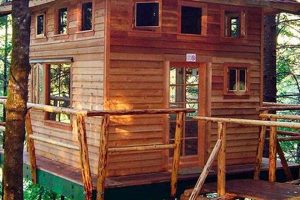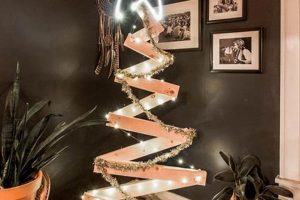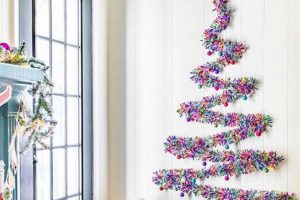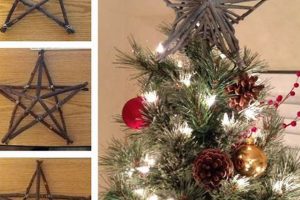The concept involves creatively adapting an artificial or real tree for seasonal display during the autumn period, specifically Halloween. This decorative undertaking frequently repurposes existing materials, emphasizing cost-effectiveness and personalization. For example, an individual might use a bare artificial Christmas tree, adorning it with orange and black ornaments, spooky lights, and themed decorations such as miniature ghosts, bats, and pumpkins.
The practice offers a unique alternative to traditional Halloween decorations, allowing for a more expansive and visually impactful presentation. It provides a canvas for individual creativity, fostering a sense of personal expression and community engagement. Its rising popularity can be attributed to a desire for distinctive seasonal displays and the increasing emphasis on sustainable crafting practices, reducing reliance on mass-produced items.
The following sections will explore specific techniques for crafting these displays, discuss popular design themes and ornamentation, and examine the practical considerations involved in selecting and preparing a suitable tree for this seasonal decoration.
Essential Guidelines for Constructing a Halloween-Themed Tree
The following outlines key considerations for successfully creating a visually appealing and structurally sound festive display.
Tip 1: Secure a Stable Base. The foundation is crucial. A weighted or otherwise secured base prevents accidental toppling, particularly important when incorporating heavier ornaments or displaying outdoors.
Tip 2: Prioritize Fire Safety. When incorporating lights, ensure they are rated for indoor/outdoor use and are in good working order. Avoid overloading electrical circuits. Opt for battery-operated options where possible.
Tip 3: Consider Color Palette. While orange and black are traditional, expanding the color scheme can enhance visual appeal. Incorporate metallic accents, deep purples, or vibrant greens for added depth.
Tip 4: Vary Ornament Sizes and Textures. Employ a range of ornament sizes to create visual interest. Combine smooth, glossy ornaments with textured, matte items for a more dynamic presentation.
Tip 5: Incorporate Natural Elements. Integrate natural items, such as dried leaves, branches, or small gourds, to add an organic touch and complement manufactured decorations.
Tip 6: Distribute Weight Evenly. When hanging ornaments, ensure the weight is evenly distributed around the tree to maintain balance and prevent leaning.
Tip 7: Utilize Themed Garlands and Ribbons. Enhance the overall aesthetic by incorporating themed garlands or ribbons that complement the chosen color palette and decorative elements. Drape garlands strategically for a cohesive look.
Adhering to these guidelines ensures a safe and visually compelling holiday display, reflecting individual creativity and attention to detail.
The subsequent section will address common challenges encountered during the assembly process and offer potential solutions to ensure a successful outcome.
1. Base Stability
The foundation of a constructed Halloween-themed tree dictates its overall stability and longevity. Without a secure and adequately weighted base, the structure is vulnerable to accidental displacement, particularly when adorned with ornaments or subjected to external forces such as wind or contact. This vulnerability directly impacts the display’s safety and visual presentation. An unstable base risks tipping, potentially damaging ornaments, the tree itself, or causing injury. Therefore, the initial selection and preparation of the support mechanism are paramount in the construction process. An example is using a Christmas tree stand as a foundation and securing additional weight, such as sandbags or concrete blocks, within the stand’s base.
Furthermore, the relationship between the base and the tree’s dimensions must be carefully considered. A taller, more elaborate design necessitates a proportionally larger and heavier base to maintain equilibrium. Conversely, a smaller, tabletop version may require a more discreet but equally effective support. The material composition of the base also plays a crucial role. A metal base offers greater durability and resistance to weathering compared to plastic alternatives. Moreover, the method of attachment between the tree trunk and the base must be secure and reliable, preventing separation or loosening over time. Some opt for welding the tree trunk to a plate, while others use bolted connections.
In summary, the concept’s successful implementation hinges upon a solid, properly weighted, and appropriately sized base. Neglecting this foundational aspect compromises the entire project’s safety, aesthetic appeal, and long-term viability. Prioritizing base stability ensures that the crafted Halloween display remains a visually compelling and secure addition to the seasonal environment.
2. Lighting Safety
The integration of illumination into a fabricated Halloween-themed tree presents inherent safety considerations that demand meticulous attention. Electrical malfunctions, overheating, or the use of inappropriate lighting components introduce fire hazards and potential electrical shock risks. The proximity of flammable materials, such as artificial foliage and fabric decorations, exacerbates these risks. The selection of lighting sources should prioritize certified safety ratings and compliance with established electrical codes. Examples include utilizing low-voltage LED lights, which generate less heat than incandescent bulbs, or employing battery-operated lighting solutions to eliminate direct reliance on mains electricity. Furthermore, thorough inspection of lighting strands for frayed wires, damaged sockets, or compromised insulation is imperative prior to deployment.
The absence of adequate safety measures can lead to catastrophic consequences. A real-world illustration involves instances where improperly installed or malfunctioning lights ignited dry foliage, resulting in structure fires and property damage. Moreover, the potential for electrical shock exists when using damaged or non-compliant lighting equipment, posing a direct threat to individuals interacting with the display. A preventative approach necessitates regular maintenance, including periodic inspection of lighting components and prompt replacement of damaged items. The application of surge protectors can mitigate risks associated with power fluctuations, and the use of timers can automate the on/off cycle, preventing overheating and conserving energy.
In summary, prioritizing illumination safety is not merely a precautionary measure but a fundamental requirement for responsible design and execution. The potential consequences of neglecting these factors are significant and far-reaching. A commitment to adherence to established safety standards, coupled with diligent inspection and maintenance practices, ensures a visually striking yet secure and hazard-free display.
3. Color Palette
The selection of a color palette constitutes a pivotal decision in the creation of a Halloween-themed tree. The chosen colors directly influence the aesthetic impact, thematic coherence, and overall effectiveness of the display. A poorly considered color scheme can detract from the intended atmosphere, while a well-executed palette enhances the visual appeal and reinforces the desired thematic elements. Cause-and-effect relationships are evident; for example, employing overly bright or pastel colors might diminish the spooky or eerie ambiance associated with Halloween. Conversely, utilizing darker, more muted tones can amplify the sense of mystery and dread. Therefore, the importance of careful color selection cannot be overstated.
Traditional Halloween decorations often feature orange and black, symbolizing autumn and darkness, respectively. However, restricting the palette to these colors alone can limit the creative potential. Incorporating complementary or analogous colors, such as deep purples, greens, or metallic silvers and golds, can add depth and visual complexity. For example, a tree adorned with black ornaments and purple lights creates a sophisticated, gothic aesthetic, while adding touches of silver can evoke a sense of spectral eeriness. Real-life examples showcase the versatility of color choices, ranging from minimalist black and white displays to vibrant, multi-hued arrangements that incorporate neon accents or glow-in-the-dark paints. The practical significance lies in the ability to tailor the color scheme to individual preferences, available resources, and the desired level of visual impact.
In conclusion, the connection between color selection and the success of a Halloween-themed tree is undeniable. The careful consideration of color relationships, thematic appropriateness, and personal preferences allows for the creation of a visually compelling and thematically resonant display. The challenge lies in balancing traditional expectations with individual creative expression, resulting in a seasonal decoration that is both memorable and aesthetically pleasing.
4. Ornament Variety
The selection and implementation of varied ornamentation are integral to the successful creation of a visually compelling and aesthetically rich fabricated Halloween-themed tree. The diversity in form, texture, and thematic representation contributes significantly to the overall impact of the display, transforming a simple structure into a focal point of seasonal decoration.
- Scale and Proportion
Ornament sizes should vary to establish visual hierarchy and prevent monotony. A mix of large, medium, and small decorations creates depth and interest. A tree adorned solely with ornaments of uniform size appears flat and lacks dynamic appeal. For example, a large, central focal-point ornament, such as a prominent ghost or skull, can be complemented by smaller, supporting decorations, like miniature bats or pumpkins. The strategic placement of different-sized elements contributes to a more balanced and visually stimulating aesthetic.
- Textural Contrast
Introducing diverse textures elevates the tactile and visual experience. Smooth, glossy ornaments juxtaposed with rough, matte, or textured items create a richer sensory experience. Consider incorporating elements like velvet bats, glittery spiders, or burlap ribbons alongside smooth glass ornaments. This textural contrast adds depth and intrigue, encouraging closer inspection and enhancing the overall aesthetic appeal of the seasonal display.
- Thematic Representation
A curated selection of ornaments that reflect different aspects of Halloween enhances thematic consistency and narrative depth. Beyond traditional ghosts and pumpkins, incorporating elements such as skeletons, spiders, witches, and black cats enriches the storytelling aspect of the display. For instance, a tree featuring a mix of classic monsters and spooky symbols creates a more layered and immersive Halloween experience. The range of thematic representations allows for a personalized interpretation of the holiday’s spirit.
- Material Composition
Varying the materials used in ornaments contributes to the visual diversity and overall aesthetic appeal. Glass, plastic, metal, fabric, and natural elements can be combined to create a dynamic and interesting display. The use of repurposed materials, such as painted pinecones or handcrafted felt ornaments, adds a personalized touch and promotes sustainability. This multi-material approach prevents the display from appearing homogenous and showcases individual creativity.
The effective utilization of these facets collectively enhances the visual impact and thematic coherence of the handcrafted Halloween tree. Ornament variety transforms a basic tree into a personalized expression of seasonal creativity, making it a prominent addition to holiday decorations.
5. Thematic Consistency
Thematic consistency is a critical element in the successful execution of a fabricated Halloween-themed tree. A unified theme provides a framework for all design choices, ensuring that individual components harmonize to create a cohesive and impactful display. The absence of a clear theme results in a disjointed and visually confusing outcome, diminishing the overall effectiveness. A well-defined theme dictates the color palette, ornament selection, lighting choices, and the integration of supplementary decorations. Cause and effect are directly linked; a clearly articulated theme produces a visually appealing and immersive display, while its absence leads to a haphazard and less engaging result.
The importance of thematic consistency is evident in its ability to establish a specific mood or atmosphere. For example, a “haunted graveyard” theme necessitates the use of dark colors, skeletal ornaments, and eerie lighting, while a “vintage Halloween” theme might incorporate antique decorations, muted tones, and classic character representations. Real-life examples demonstrate this principle; a tree decorated solely with mismatched ornaments and clashing colors lacks the visual impact of a tree deliberately designed around a specific concept. This coherence is not merely aesthetic; it provides a narrative framework, enabling the display to tell a story and evoke a particular emotional response. This is possible with DIY Halloween tree.
The practical significance of understanding thematic consistency lies in its ability to guide the design process, preventing costly mistakes and ensuring a visually satisfying final product. Challenges in maintaining thematic unity often arise from a lack of pre-planning or a failure to critically assess the individual components. Ultimately, thematic consistency ensures that the crafted tree aligns with the desired aesthetic, thereby achieving the intended goal of creating a visually striking and thematically resonant Halloween decoration. The effective DIY Halloween tree showcases planning skill.
6. Material Repurposing
Material repurposing is intrinsically linked to the creation of self-made Halloween trees, reflecting a sustainable and cost-effective approach to seasonal decoration. The practice involves creatively transforming discarded or underutilized items into decorative elements, thereby minimizing waste and maximizing resourcefulness. A direct cause-and-effect relationship exists: the deliberate selection and manipulation of existing materials directly impact the aesthetic character and the overall environmental footprint of the resulting display.
The importance of material repurposing is underscored by its contribution to resource conservation and the reduction of consumer waste. Examples of this practice are widespread: plastic bottles can be transformed into ghostly apparitions, cardboard boxes into tombstones, and old clothing into fabric wraiths. Discarded wire hangers can be reshaped to create skeletal figures, while fallen branches from trees can form the foundation for spooky centerpieces. These examples demonstrate the adaptability of readily available materials and their potential for creative transformation. The practical significance lies in the opportunity to craft unique and personalized decorations without incurring significant financial expenditure. This element is a key aspect of the do-it-yourself philosophy, emphasizing ingenuity and skill.
In conclusion, material repurposing is not merely a cost-saving measure but a core tenet of sustainable crafting, significantly enhancing the creative scope and ethical standing of Halloween-themed tree projects. The challenge lies in identifying the inherent potential within discarded items and transforming them into compelling decorative elements. The effective integration of repurposing techniques contributes to the creation of visually appealing and environmentally responsible seasonal decorations.
7. Structural Integrity
Structural integrity is a non-negotiable aspect of any fabricated Halloween tree. This refers to the capacity of the assembled structure to withstand applied loads, resist deformation, and maintain its intended configuration under expected environmental conditions. Failure to address structural considerations results in a hazardous display prone to collapse, posing risks to property and individuals.
- Base Stability and Load Distribution
The base of the fabricated tree must provide sufficient support to counteract the weight of the tree itself, along with all attached ornaments and decorations. An inadequately sized or weighted base leads to instability, increasing the likelihood of tipping. Even distribution of ornaments is crucial; concentrating weight on one side compromises balance and places undue stress on supporting members. For example, a top-heavy tree with a small base is inherently unstable, while an asymmetrical distribution of ornaments exacerbates this risk. Reinforcing the base with additional weight or employing a wider support structure enhances stability and mitigates potential hazards.
- Material Selection and Connection Strength
The selection of appropriate materials is paramount for the structural integrity of the tree’s framework. Lightweight, flimsy materials are unsuitable for supporting substantial weight or resisting wind forces. Connection points between branches and the central trunk, or between different sections of the tree, must be robust enough to withstand tensile and shear stresses. Weak connections lead to separation or breakage under load. Real-world examples include using metal wire or strong adhesive to reinforce branch attachments, or employing a sturdy central pole capable of bearing the weight of the entire structure.
- Wind Resistance and Environmental Factors
Outdoor Halloween displays are subject to wind forces that exert significant pressure on the structure. A structurally sound tree must be designed to withstand these forces without collapsing or shedding decorations. Secure anchoring of the base to the ground, along with aerodynamic shaping of the tree’s profile, can improve wind resistance. Furthermore, material selection must account for environmental factors such as moisture, temperature fluctuations, and UV exposure, which can degrade materials and weaken structural integrity. For example, a tree constructed from untreated wood is susceptible to rot and decay, while plastic components may become brittle and crack under prolonged sun exposure. Protective coatings and weather-resistant materials enhance the durability of the display.
- Assembly Methods and Quality Control
The method of assembly significantly influences the overall structural integrity of the fabricated tree. Loose or improperly tightened connections create weak points that can fail under stress. Quality control measures, such as thorough inspection of connections and load testing, ensure that the tree meets the required structural standards. For example, using locking mechanisms on branch attachments or conducting a weight test prior to full decoration can identify and rectify potential weaknesses. Careful assembly and rigorous quality control are essential for ensuring a safe and durable display.
The interconnectedness of these facets underscores the holistic nature of structural integrity in Halloween tree design. Prioritizing these considerations from the outset ensures that the resulting display is not only visually appealing but also safe and resilient, capable of withstanding the rigors of seasonal display and environmental exposure. The structural element of Halloween tree DIY is fundamental and should be the main priority.
Frequently Asked Questions
The following addresses common inquiries regarding the construction, safety, and aesthetic considerations related to creating a self-made Halloween-themed tree.
Question 1: What constitutes an acceptable base for a large, outdoor display?
A suitable base for a sizable outdoor Halloween tree requires significant weight and stability. Options include a weighted Christmas tree stand filled with sand or concrete, a repurposed metal drum also filled with ballast, or a custom-built wooden platform with a broad footprint. The base’s weight should exceed the combined weight of the tree and its decorations to prevent tipping due to wind or other external forces.
Question 2: What fire safety precautions are essential when using electrical lights?
When incorporating electrical lighting, utilize only lights specifically rated for outdoor use and bearing safety certifications from recognized testing laboratories. Regularly inspect the wiring for damage or fraying. Avoid overloading electrical circuits by adhering to the manufacturer’s wattage guidelines. Consider using battery-operated LED lights to minimize electrical hazards and reduce energy consumption.
Question 3: How can the cost of crafting a display be minimized?
Cost reduction can be achieved through material repurposing. Utilize discarded items such as plastic bottles, cardboard boxes, and old clothing to create ornaments and decorations. Collect fallen branches and leaves for natural accents. Explore thrift stores and garage sales for inexpensive decorative elements. Consider collaborative projects with friends or neighbors to share resources and reduce individual expenses.
Question 4: What methods can improve wind resistance for outdoor displays?
Wind resistance can be enhanced by securing the base to the ground using stakes or anchors. Employ aerodynamic shaping techniques to reduce wind drag. Use lightweight ornaments to minimize wind load. Consider partially sheltering the display from prevailing winds using natural or artificial windbreaks. Regular inspection and maintenance are essential for identifying and addressing potential weaknesses.
Question 5: What materials are best suited for creating durable, weather-resistant ornaments?
Durable, weather-resistant ornaments can be crafted from materials such as treated wood, plastic, metal, or exterior-grade fabrics. Apply protective coatings such as sealant, paint, or varnish to prevent moisture damage and UV degradation. Consider using materials inherently resistant to weathering, such as marine-grade plywood or stainless steel, for critical structural components.
Question 6: How is a consistent theme achieved across all decorative elements?
Thematic consistency is achieved through meticulous planning and deliberate selection of decorative elements. Begin by defining a specific theme, such as “haunted graveyard” or “vintage Halloween.” Select colors, ornaments, and lighting that align with the chosen theme. Avoid incorporating elements that deviate from the established aesthetic. Maintain a consistent level of detail and craftsmanship across all components to reinforce the thematic unity.
Understanding these aspects provides a foundation for creating a safe, visually appealing, and cost-effective Halloween-themed tree. Thoughtful planning and careful execution are crucial for realizing a successful display.
The subsequent section will address innovative design concepts and emerging trends in the creation of Halloween trees, offering inspiration for advanced crafting projects.
Conclusion
The preceding exploration has detailed the multifaceted nature of crafting a seasonal tree, addressing structural integrity, safety considerations, aesthetic principles, and the value of resourcefulness. The analysis extends from foundational elements like base stability and fire safety to thematic coherence, ornament variety, and material repurposing. The synthesis of these distinct yet interconnected facets directly impacts the success and sustainability of constructed displays.
The creation of a “diy halloween tree” represents more than a seasonal craft; it embodies a confluence of creativity, resource management, and adherence to safety protocols. Further engagement with these principles will cultivate both imaginative expression and responsible design practices, ensuring the continued evolution of this seasonal decoration.







